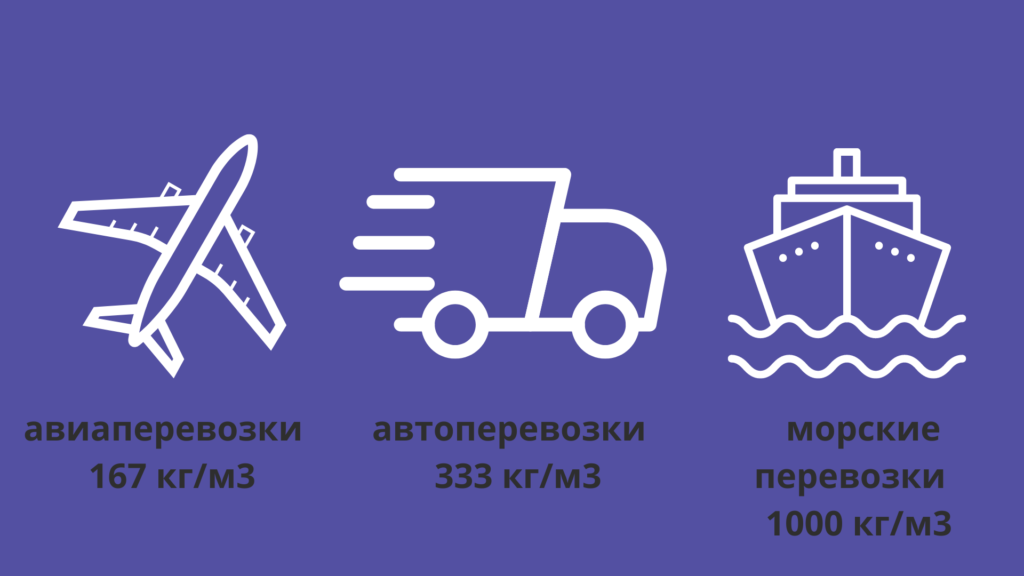The cubic capacity of a load, also known as volumetric weight, is an important characteristic in transport and storage. The calculation of this indicator allows you to:
It can also be useful in a number of other cases. The standard formula for calculating the volumetric weight of a shipment is:
LxWxH (in centimetres) / 5000
However, international shipping is full of nuances that we want to share in this article. For example, some companies, such as DHL, use the 4000 divisor (but only for shipments within England).
It is equally important (in our opinion) to tell you when you will need to calculate the volumetric weight of your cargo and what nuances you should take into account to make your logistics operations as efficient as possible.
A childhood riddle comes to mind: “What is heavier: a kilogram of stones or a kilogram of down?”. Carriers are guided by similar logic. After all, the volume of the cargo compartment is limited, and it is not economically viable to charge by weight for large volumes.
Therefore, to increase profitability, the cubic capacity indicator is used. It allows you to correctly calculate the usable volume of the room and establish the fair value of services.
The cubic weight is a standard indicator approved in global practice that reflects the density, compares with the actual weight and allows you to obtain the estimated value of the occupied space.
As a rule, the calculation of the volumetric weight of cargo is used for air or road transport. In the case of sea delivery, the system of freight is used – payment per container. Only in some cases do sea carriers also use the cubic metre calculation.
It is also important to understand that each mode of transport has its own adjustment factors calculated based on the cost of the service and cargo capacity.

In various documents or calculators from the freight carrier, you may come across the terms “gross”, “actual” and “payable” weight. The fact is that the larger figure is always taken as the basis.
Step 1: Measurement
You need to measure the length, width, and height of each item. For this purpose, the metric system is used because it is generally accepted that the result should be in centimetres.
Important! Figures are always rounded up. If your product is 144.5 cm long, round up to 145 cm for the following calculations. Determine the parameters of the goods in the package.
For example, our task is to send 5 microwave ovens by air. Let’s find the parameters of one of them:
length – 53.5 cm = 54 cm
height – 44 cm
width – 29 cm
Step 2: Calculate the volume of each element
Once you have the measurements, calculate the volume of each item by multiplying the length by the width and the height. Then add all the volumes together to get the total volume.
V = 54 x 44 x 29 = 68904 – we convert centimetres to metres and get 0.0689 m3.
The total volume (we have 5 boxes in our example) is 0.3445 m3.
Step 3: Apply the coefficient
0.3445 m3 x 167 = 57 kg.
Step 4: Comparing the estimated and actual weight
One microwave oven with the box weighs 9 kg, so 9×5 = 45 kg. So, as a result, the carrier will charge your shipment as a 57 kg shipment. In this example, the difference is relatively small, but when it comes to tonnes of goods, these figures can be shocking.
Important! In the example, we calculated the cubic capacity with the transport adjustment factor, but as mentioned above, there is another calculation method with a divisor of 5000. In this case, we would get:
54 x 44 x 29 = 68904/5000 = 13.7 (14 kg) * 5 pieces = 70 kg.
The choice of methodology depends on the country of shipment/receipt, the type of transport, the manufacturer’s agreements with the logistics company, etc.
It is not always the case that simple geometric shapes such as parallelepipeds or cylinders can be used as cargo. Therefore, when calculating the cubic capacity, keep in mind that some items may be packed together or have gaps between them. In some cases, such as when stacking goods in a container, space is left between items to prevent damage during transport. Measure the dimensions of these spaces and add them to the total volume of the shipment.